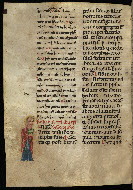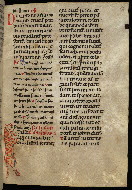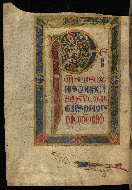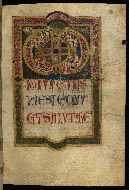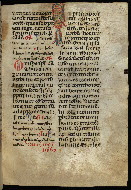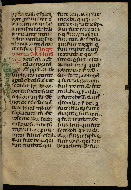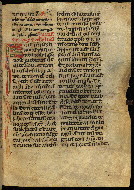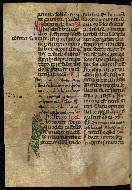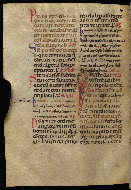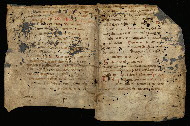Home > Digitized Walters Manuscripts
This document is a tranformation of a TEI P5 XML manuscript description incorporating images. If you have trouble reading special or non-Latin characters on this page, please make sure you have appropriate Unicode fonts installed and an up-to-date web browser.
Walters Ms. W.75, The St. Francis Missal
Browse images (Browse images in a new window) | TEI in XML format
W.75
The St. Francis Missal
Known today as the St. Francis Missal, this manuscript is traditionally believed to be the very book consulted by St. Francis and his companions in 1208. According to early accounts, St. Francis and two followers were debating what God’s plan for them might be. Unable to decide, they sought answers at the church of San Nicolò in Assisi, which Francis often attended. They opened the Missal, which sat on the altar, three times at random and in every case, the text on the page urged renouncing earthly goods. This pivotal moment laid the foundation for the Franciscan order. An inscription in the book on fol. 166r lends support to the legend that surrounds it, for it documents the Missal's creation for the church of San Nicolò, and also mentions the book's patron, Gerard of Ugo, who is documented in Assisi in the late 12th century. Due to its possible contact with the saint, Franciscans worldwide consider it to be a relic of touch, and every year many make pilgrimages to Baltimore to be in its presence, and to see the three places they believe Francis opened the manuscript to (fols. 119v-120r, 132v-133r, and 249v-250r). The manuscript underwent intensive conservation from 2017-2019, a special project made possible by the Mellon Foundation.
Ca. 1200 CE
Umbria, Italy
Book
Liturgical
The primary language in this manuscript is Latin.
- Transliteration: "Scitote omnes scrire volentes, eum nomine Girardum Ugonis, de quo in hac pagina mentio habetur, omnium beneficiorum, totiusque sacrificii esse participem, quae in hac ecclesia beati Nicolai per aliquem clericum vel clericos fuerint celebrata. Quoniam ipse idem bonum et utile pro iam dicta ecclesia iugiter est operatus. Quare dignum esse videtur, juxta sacram scripturam, suum bonum non esse inremuneratum."
- Translation: All (you) desiring to know, know this: that he (who goes by the) name Gerard of Ugo – and concerning whom this page is rightly kept – is a partaker of every sacrifice and of all benefices which are celebrated by any one cleric or clerics in this, the church of blessed Nicolò. At the same time, he himself has worked tirelessly (to bring about) every good and useful (thing) for this above mentioned church. Thus, it seems proper and in accord with the Holy Scriptures that he be given just remuneration…
Parchment
Medium-weight parchment, with a fair amount of flaws, holes; heavily grimed and worn from use
Foliation: ii+285+ii
Foliation in upper right corners, rectos; flyleaves are modern parchment
Formula: Quires 1-28: 10, with fol. 115 hooked to fol. 116, and fol. 231 hooked to fol. 240 (fols. 1-278); Quire 29: 6, with the 7th and final leaf hooked on (fols. 279-285)
Catchwords: Catchwords written horizontally in middle of bottom margin on verso of last leaf in quire
Comments:
21.2 cm wide by 29.7 cm high
14.0 cm wide by 22.0 cm high
- Columns: 1-2
- Ruled lines: 26
- Layout does not apply to calendar
- Title: Missal
- Hand note: Textura
- Decoration note: One full-page miniature of Crucifixion doubling as "T" initial, two large half- to full-page illuminated initials, and nine decorated initials (six are figurative, averaging 9-12 lines) in pigments including orpiment, ultramarine, and some very oxidized silver; initials throughout in alternating red and blue (1-2 lines); rubrics in red; text in dark brown to black ink
- Title: Temporale
- Rubric: Dominica I de adventu
- Incipit: Sequentia sancti evangelii
- Title: Ordinary of the Mass
- Decoration note: Full-page illuminated initial fol. 162v, half-page initial fol. 163r, and full-page Crucifixion/"T" fol. 166v
- Title: Proprium de Sanctis
- Title: Sanctorale
- Title: Commune Sanctorum
- Title: Special Masses
- Title: Mass for the Holy Sacrament
- Hand note: Written in a second hand
- Title: Calendar (slightly later addition?)
- Contents: Calendar half-full on average, graded in red and black ink; saints of note include St. Nicolas (translation, May 9), St. Rufinus (Aug. 11); many names added, and some later erased but visible through UV light - each page had about a dozen erasures, with most commemorating the dates of deaths of members of the parish in Assisi; added names include St. Clare (Aug. 12) and Obit. for Bishop Guido (d. July 30, 1228); St. Francis (Oct. 4) added but later erased
- Hand note: Different hand from both Missal itself and dedicatory inscription on fol. 166r; possibly added to manuscript early; has been suggested calendar may originally been intended for use in a church connected to St. Rufinus in Assisi, as references to St. Rufinus appear on fols. 282v and 283v
fol. 65v:
fol. 80r:
fol. 162v:
fol. 163r:
fol. 166v:
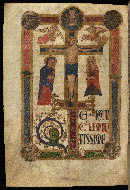
- Title: Crucifixion in form of historiated initial "T" of "Te igitur"
- Form: Full-page historiated initial "T"
- Text: Cannon of the Mass
fol. 174r:
fol. 180r:
fol. 203r:
fol. 219v:
fol. 229v:
W.75.Rel.1:
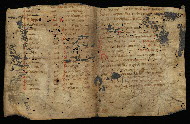
- Title: Front pastedown, fragment of earlier liturgical manuscript
- Form: Binding waste ca. 10th-11th century?
- Comment:
Now removed from binding and housed separately in book box
W.75.Rel.2:
The binding is not original.
Rebound in fifteenth century in simple monastic style, with beech wood boards partially covered with leather; later infestation of wood-boring insects caused severe weakening that led to the eventual cracking of the boards; during 19th-century restoration, the old leather cover was replaced with one of a poor quality sheepskin leather, which rapidly deteriorated quickly; from 2016-2018 Mellon Fellow and book conservator Cathie Magee took the book completely apart to stabilize all components, injecting a modern stable adhesive into the insect holes and rebuilding losses in the boards with epoxy; thick deposits of glue were cleaned off the spine folds, and holes and tears in the parchment were mended with Asian paper Once this work was completed, Magee reassembled the gatherings (groups of pages) and sewed them onto four double linen cords using a traditional techniques and a sewing frame, as seen on the right. New linen end bands were sewn onto the text block, and the boards were reattached. Finally, the binding was covered with new goatskin leather, leaving much of the boards exposed as before.
Created for the Church of San Nicolò, Assisi, late twelfth or early thirteenth century, likely under the patronage of Gerard of Ugo (inscription naming him, and identifying the book as made for San Nicolò, found on fol. 166r)
Joseph Baer, book dealer, Frankfurt, Germany; listed with photograph of fol. 166v in catalogs of 1905, 1912, and 1924
Gruel firm, Paris, ca. 1924 (run at this time by Paul Gruel after the death of his father, Léon Gruel, in 1923)
Henry Walters, Baltimore, acquired from Paul Gruel ca. 1924
Walters Art Museum, 1931, by Henry Walters' bequest
Faloci-Pulignani, Michele. "Il messale consultato da S. Francesco quando si convertì," Miscellanea Francescana, 15 (1914): 33-43.
De Ricci, Seymour. Census of Medieval and Renaissance Manuscripts in the United States and Canada. Vol. 1. New York: H. W. Wilson Company, 1935.
Brunacci, Aldo. "From These Pages," Messenger of St. Anthony (Padua, October, 1978): 16-19.
Perseghin, Gerard A. "Prime Candidate for Assisi Missal at Hand," The Catholic Review, December 25, 1981.
Porter, Vicki. "Brother Book?". 35 No. 2. The Walters Art Gallery Bulletin. March/April, 1982:1-2.
Voorvelt, G. C. P. and Van Leeuwen, B. P., “L'Evangéliaire de Baltimore: Étude critique sur le missel que saint Françoise aurait consulté,” Collectanea Franciscana 59 (1989): 261-321.
Niemier, Roch, O.F.M. Franciscan Life, Day One: 800 Years 1209-2009: Reflections on the Missal of San Nicolo. Franciscan Pilgrimage Programs, Inc., 2008.
Thompson, Augustine, O.P. Francis of Assisi: The Life. Cornell University Press, 2013, p. 26
Herbert, Lynley Anne. "A Curator’s Note: The Tarnished Reception of Remarkable Manuscripts," in Illuminating Metalwork: Metal, Object, and Image in Medieval Manuscripts, edited by Joseph Ackley and Shannon L. Wearing. De Gruyter, 2020.
Principal cataloger: Herbert, Lynley
Catalogers: Herbert, Lynley; Walters Art Museum curatorial staff and researchers since 1934
Editor: Herbert, Lynley
Conservators: Magee, Cathie; Quandt, Abigail
Contributors: Damon, Elena; Emery, Doug; Herbert, Lynley
The Walters Art Museum
Licensed for use under Creative Commons Attribution-ShareAlike 3.0 Unported Access Rights, http://creativecommons.org/licenses/by-sa/3.0/legalcode. It is requested that copies of any published articles based on the information in this data set be sent to the curator of manuscripts, The Walters Art Museum, 600 North Charles Street, Baltimore MD 21201.
